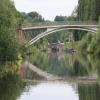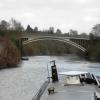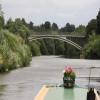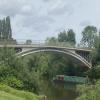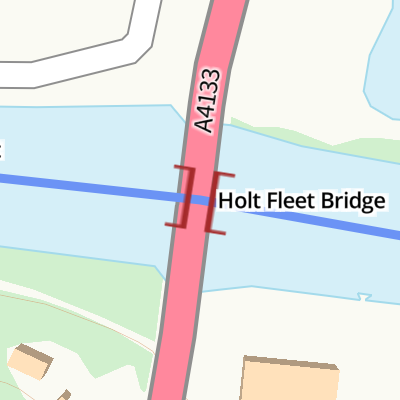
Mooring here is impossible (it may be physically impossible, forbidden, or allowed only for specific short-term purposes).
There is a bridge here which takes a major road over the canal.
| Hawford Junction | 2 miles, 6 furlongs | |
| Severn - Salwarpe Junction | 2 miles, 5¼ furlongs | |
| Grimley | 2 miles, 2¾ furlongs | |
| Holt Castle | 6 furlongs | |
| The Wharf Inn and Campsite (Holt Heath) | 1 furlong | |
| Holt Fleet Bridge | ||
| Holt Lock Landing Pontoon | ½ furlongs | |
| Holt Lock Weir Exit | ¾ furlongs | |
| Holt Lock (Holt Fleet) | 1¾ furlongs | |
| Holt Lock Weir Entrance | 4 furlongs | |
| Lenchford Ferry | 1 mile, ¼ furlongs | |
- Visit the Holt Fleet Bridge and discover its history - Industrial Tour — associated with this page
- Find out the best way to visit the Holt Fleet Bridge, how long it takes to see, how to get there, and info on its history and architecture.
Mouseover for more information or show routes to facility
Nearest water point
In the direction of Limit of Navigation
In the direction of Diglis Junction
Nearest rubbish disposal
In the direction of Limit of Navigation
In the direction of Diglis Junction
Nearest chemical toilet disposal
In the direction of Limit of Navigation
In the direction of Diglis Junction
Nearest place to turn
In the direction of Limit of Navigation
In the direction of Diglis Junction
Nearest self-operated pump-out
In the direction of Limit of Navigation
In the direction of Diglis Junction
Nearest boatyard pump-out
In the direction of Limit of Navigation
In the direction of Diglis Junction
Wikipedia has a page about Holt Fleet Bridge
Holt Fleet Bridge, also known as Holt Bridge, is a cast-iron arch bridge over the River Severn, at Holt in Worcestershire, England. It has a span of 150 feet (46 m); it was designed by Thomas Telford and opened in 1828. It is Grade II listed, and is similar to Telford's Galton Bridge, which is a Grade I listed structure that spans his BCN New Main Line canal at Smethwick.
The bridge was built with five cast-iron ribs, with X-braced spandrels, as were several of Telford's bridges. It was strengthened in 1928. when the upper and lower parts of each rib and some of the diagonal struts above them were encased in concrete. The road deck was rebuilt in reinforced concrete and widened at the same time.
Semicircular arches at each end, built in red sandstone, allow for the passage of riverbank foot-traffic and floodwater.

